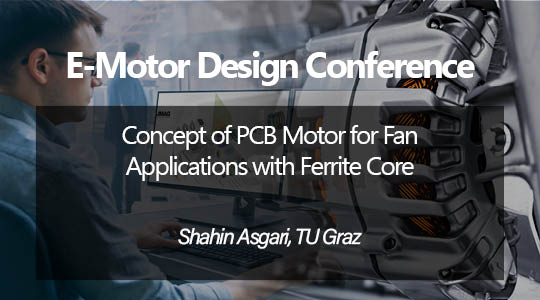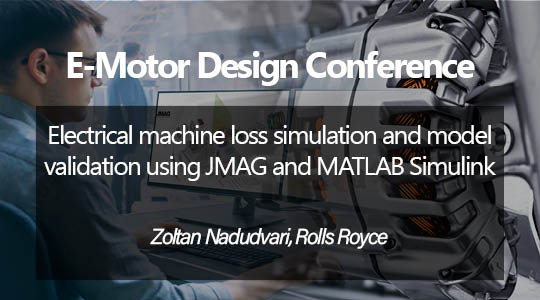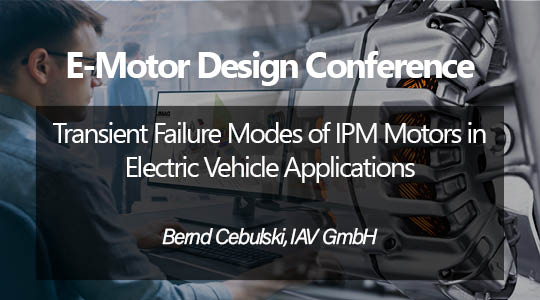Find everything you need on our resources center, product brochures, presentations, papers and more.
Login or create an account and get full access

A time-efficient method is presented that enables the calculation of EESM maps in a short timeframe, with a high degree of accuracy.

The demands on the materials and insulation systems of the winding system are constantly increasing. With electrostatic 2 and 3D JMAG simulations, the electric field strengths in the slot, at the slot exit and in the winding head can be calculated precisely and quickly.

This work demonstrates a Valeo's approach to electric machine optimization starting from the vehicle requirements level.

In this keynote presentation, we explore the challenges of simulating Axial Flux Machines (AFM) in high-speed traction drive applications using JMAG.

The study covers coupled optimization of active electromagnetic components (such as magnets, copper, and lamination) and passive electric components (e.g., insulation paper, winding coating and wedges) in electric machines

Electrical machines in traction applications are operated in inverter-fed operation over wide speed ranges. The special demands on compactness and high efficiencies of those e-machines lead to high expectations on the FEA simulation accuracies.

Higher fill factor of concentrated winding allowed to increase power density of machines even for their air cooling configurations, Results of sImulations were validated on in-house test-bench and demonstrated good accuracy with experiments.

Multi-body dynamics simulation used to predict excitations of an electric powertrain including electromagnetic forces calculated by commercial software JMAG. Seamless integration of multi-body dynamics, electromagnetics, and acoustic radiation prediction along with creation of audible sound files were demonstrated for the NVH assessment of electric powertrains.

In this presentation we will discuss the validation in JMAG of the control and dynamics of a linear switched reluctance motor, including electromagnetic analysis of the whole machine, linear movement and power electronics simplification.

The motor’s design is explained in detail and, for proof of concept, investigations in the no-load and load conditions are performed using finite element analyses. In addition, important design considerations are discussed. The findings confirm the practicality of the proposed low-cost and straightforward motor topology.

The presentation will focus on concept development of hairpin wound E-motors for E-mobility and showing the importance of the Jmag optimization tools in early concept studies.

If d-q model and FEM Coil Inductance methods are not feasible to determine the proper inductances of synchronous machines, then the differential inductance must be calculated directly. The differential self- and mutual inductances can be derived by stored energy methods. This presentation shows how the required inductances can be evaluated quickly and accurately by using a user defined post calculation script.

The design process for these efficiency and power-density driven optimizations is very evolved and highly application specific. For electric machine optimization, JMAG Designer, and especially the scripting capability, plays a crucial role in our design process.

The presentation will be about how JMAG is utilized for layout design and conductor size optimization of hairpin windings in a typical traction PM motor.

The industry poses specific challenges for the development engineers due to the strict requirements and design boundary conditions. Developing an electrical drive train which meets the high safety standards, the desired efficiency and power to weight ratio requires a multidisciplinary design approach to cover all of the requirements and design aspects.

EV Motors driven by voltage source inverters can suffer from a variety of different failure mechanisms.From the influence of the functional safety behavior of the entire drive system, the decrease of performance and efficiency or lead to excessive noise. This paper will provide some approaches and examples of failure simulations coupling JMAG with the inverter control reaction.

The presentation will focus on different aspects of E-motor design and control where JMAG tool-chain has a major contribution.

Market requirements and the need for reduced emissions are pushing the demand for hybrid and electric traction both in the transportation and in the off-highway sectors. Over the next years e-drive units and e-axles will continue to evolve to meet industry specific requirements like increase in power density, efficiency improvement, weight and cost reduction, reliability.

While these analyses may typically be managed by different engineers, or even different departments, there is a growing need for increased collaboration. This presentation will detail several avenues for increased collaboration of motor integration to improve NVH behavior.